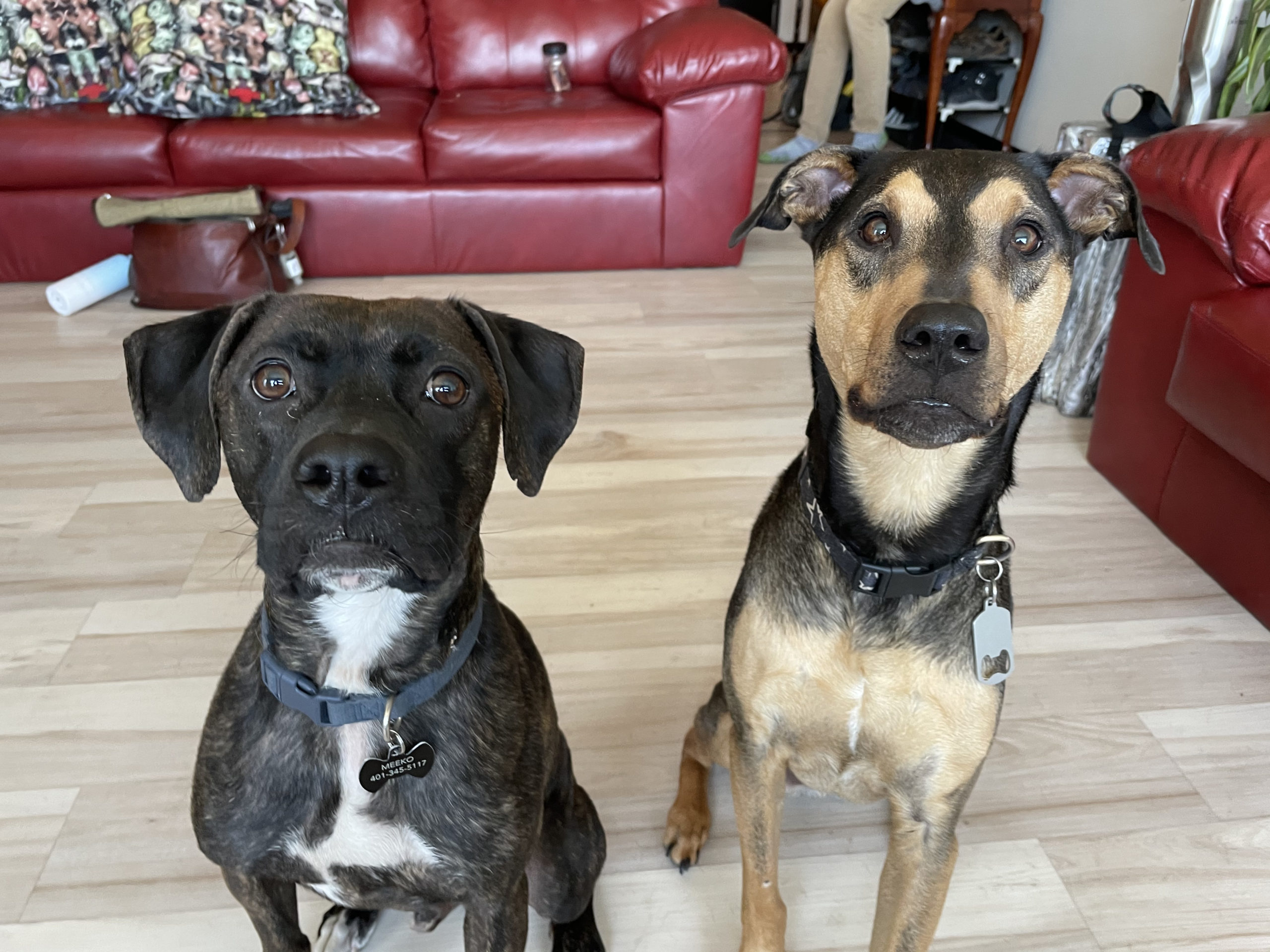Helping a High Energy Boxer Stop Acting Aggressive on the Leash
By: David Codr
Published Date: May 6, 2021
For this Omaha dog training session worked with Sebrastian (right) and his new roomie, 1 year-old Boxer mix Meeko, sharing tips to stop him from acting aggressive to other dogs on the leash or lunging out the elevator doors.
Meeko and Sebastian were both very excited to meet me when I arrive for the session. I noticed that when the guardian’s roommate returned home, he petted and engaged with the dogs when they were overexcited doing a little jumping.
While I am always happy to see my dogs when I return home, I refrain from petting them or giving them attention when they are overly excited. It took a little bit of time, but now my dogs understand that they don’t have to be over excited to meet me and communicate that they are happy that I’m home. Just like people, dogs are more prone to making mistakes when they’re overstimulated and humans confusing excitement for happiness is one of the more common reasons dogs get over excited. It may seem like a little thing, but ignoring your dogs until they are calm can help them learn to calm themselves down which is an important ingredient when it comes to developing self-control.
Whenever you have a dog that has a reactivity problem, as Omaha’s resident dog behavior expert I have found it is advisable to find ways for them to practice some self-restraint and self-control outside of the thing that causes them to be reactive. Later in the session I showed the guardian the leave it cue which is another outstanding way to develop self control.
If you have a dog that is reactive to other dogs or your dog has leash aggression, it’s important that you find ways to develop a positive association with whatever they are reacting at or two. Since Meeko can go to the dog park and play with dogs off leash, he does not have a dog aggression problem.
Many dogs who have a leash aggression issues are frustrated by the leash. Sometimes this is because the Guardian holds the leash too short or applies corrections when the dog is reactive or uses tools that cause the dog pain or discomfort on the leash such as choke chains, pinch and prong collars. Fortunately, Meeko’s guardian was not using any of those aversive training tools.
That said, the dog did a lot of pulling on the leash when we were heading out to go for a potty break. This can also contribute to frustration which can lead to stress which can turn into aggression.
One of the dog behavior tips I shared with the guardian was to practice some loose leash walking on the hallway trip to the elevator. Each time that Meeko got to the end of the leash, I had the guardian make a kissing sound while simultaneously holding out a treat. This caused Meeko to turn around to see where the sound was coming from and once he saw the treat, he quickly trotted over. If the guardian practices this exercise every time they take the dog out, it shouldn’t take long before Meiko starts turning around and coming back to the guardian every time he gets to the end of the leash.
Although it doesn’t seem related, if the guardians can teach Meeko to walk with a loose leash, they can alleviate a lot of the frustration that is a contributing factor to his leash aggression.
When we got outside, I set up my camera so that I could show the guardian how to play the engage disengage game to start helping Meeko build up a positive association with other dogs while he is on the leash. You can learn how to use the engage disengage game to stop dogs with leash aggression by watching the free positive dog training video below
The guardian will need to find an area where there is a lot of dogs walking by on a set path so that he can find the appropriate distance to practice this trick to stopping dogs from acting aggressive when on the leash.
Since Meeko is a high energy dog, it would be best if the guardian can practice this exercise to stop leash aggression after Meiko has been exercised and given ten minutes to recover.
It’s going to take some practice by the guardian before the dog will stop acting aggressive to other dogs went on the leash.
But there were‘s indications that Meeko can get over his leash aggression problem earlier in the session. On our way outside to shoot the above video, we practiced an exercise in the elevator to stop Meiko from lunging out the door as soon as he hears the door start to open. in the middle of practicing this exercise we arrive to the floor where someone was waiting to get on the elevator with the dog. Normally this is a situation that would cause Meeko to growl bark and lunge but instead all he did this time was get stiff and stare. His guardian remarks that was the first time he has not barked or longed when seeing another dog in the elevator.
Here is the video that we shot in the elevator, conditioning Meeko to stop trying to bolt out the door as soon as it opens.
I recommended that the guardian record the sound of the tone the elevator makes right before the doors open. This will allow him to start scattering treats on the floor as soon as he plays the recording so that Meeko starts to associate the tone with a habit of searching the floor for treats. This is a classically conditioned response that is easy to achieve with a little bit of practice.
To help the guardian remember all of the dog behavior tips and secrets that we covered in this in-home downtown Omaha dog training session, we recorded a roadmap to success video that you can check out below
Categorized in: Dog Behavior


